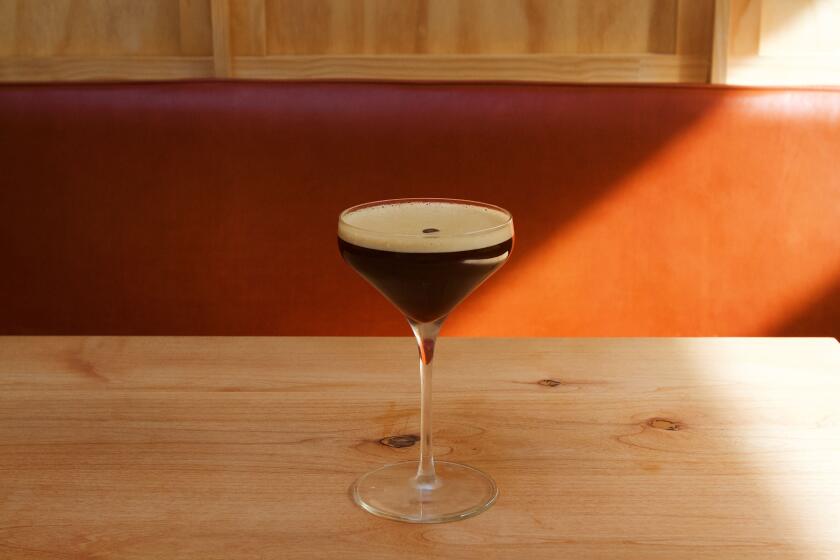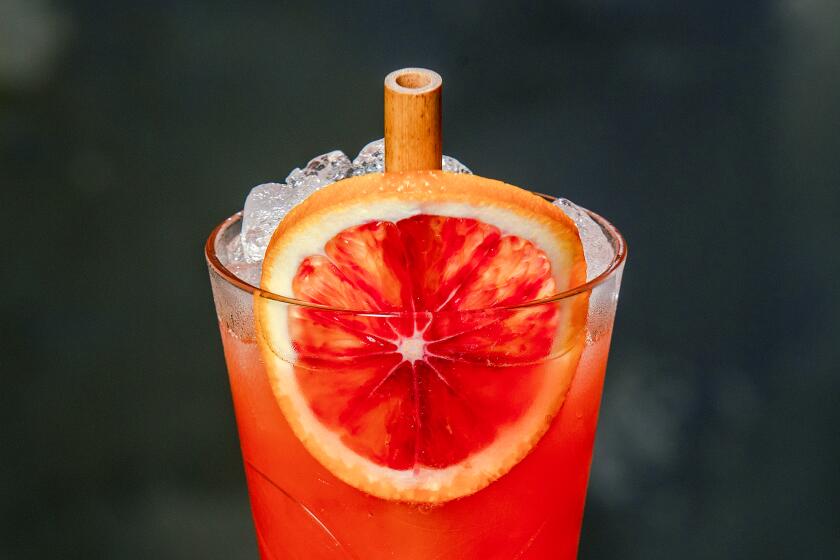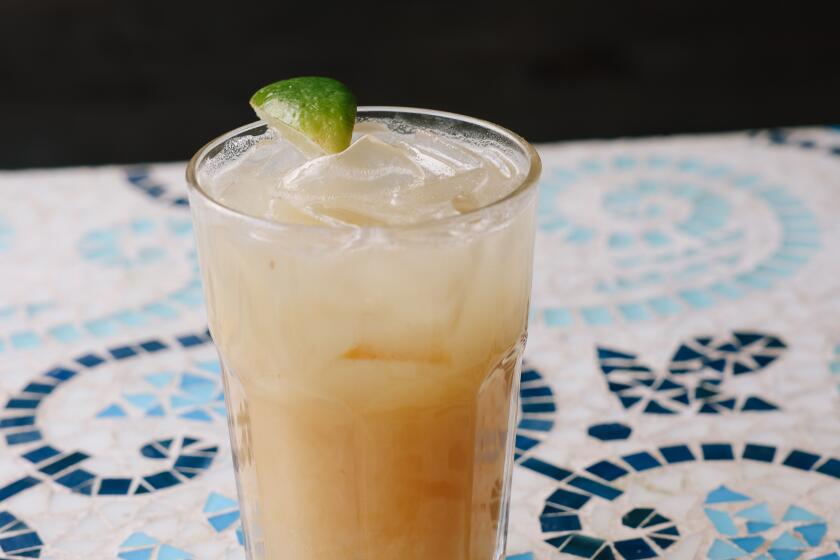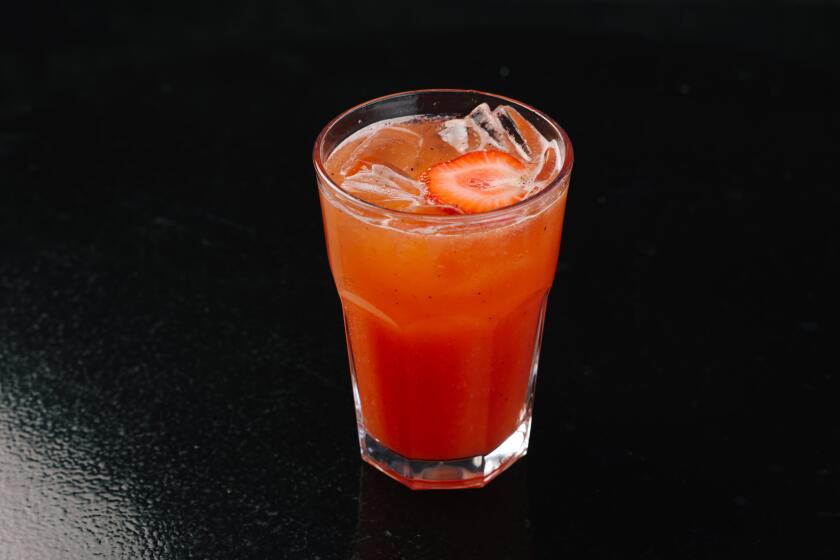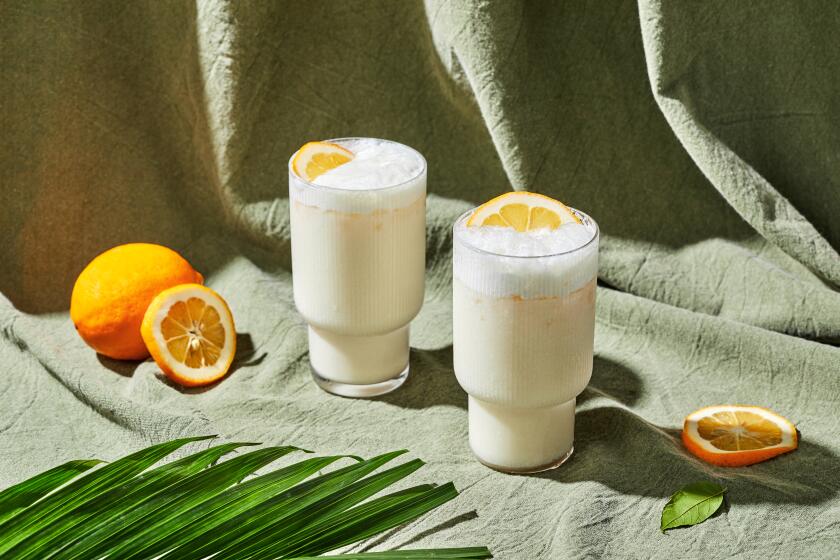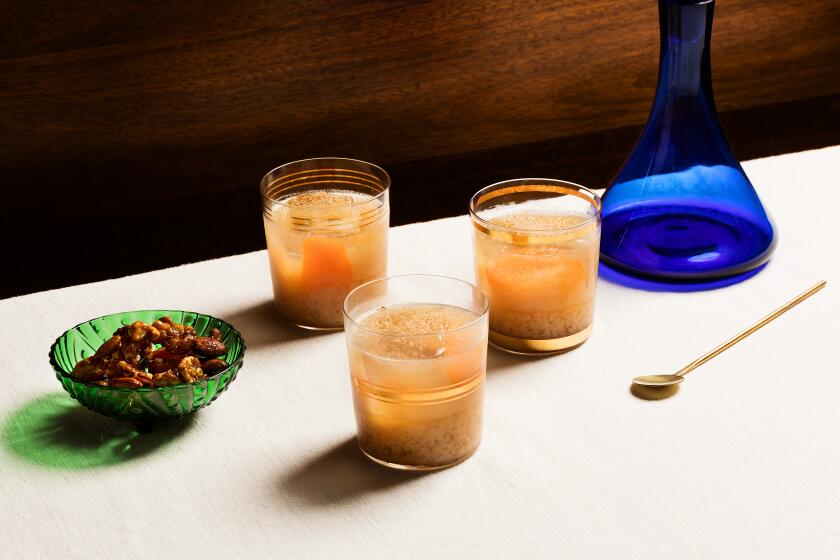Blood orange jalapeno margarita
Saddle up and make your way to any self-respecting watering hole these days and a classic margarita -- fresh lime juice, pure agave tequila and orange liqueur -- is only a few shakes away. But there’s something about sipping this sweet-tart icon of summer on a chilly winter afternoon that’s a bit unsettling, like slurping eggnog on the Fourth of July.
All hail the winter margarita, a new family of cocktails that capitalizes on the many tequila-friendly fruits of the season such as grapefruit, blood oranges, guavas, even pomegranates.
“Winter margaritas should be warmer, with more complex layers of flavor than their summer counterparts,” says Tim Staehling, lead bartender at the Hungry Cat. “Slightly bitter citrus fruits like grapefruit work well, but so do sweeter winter fruits, like persimmons, as long as you balance them so they’re not too tart or sweet.”
Finding that sour-sweet equilibrium requires a bit of tinkering. Even with the classic margarita combination, getting it right can be tricky. The key is to add sufficient tanginess to counter the sharpness of the tequila and to keep the sweetness, usually from a liqueur, subtle.
At Border Grill, classic margaritas get a splash of lemon juice to temper the acidity of stateside limes and open up their flavor.
“Mexican limes tend to be less astringent, a little sweeter, than the limes we find here, so we add lemon juice to approximate their flavor,” says Mary Sue Milliken, co-owner of Border Grill in Santa Monica and Las Vegas. “It really brightens up the lime juice and gets the sweet-sour thing going that’s key to a good margarita.”
The zesty lemon-lime combo also perks up softer, sweeter winter citrus fruits, such as the just-in blood oranges featured in Border Grill’s blood orange and jalapeno margarita.
To make a similar version at home, infuse tequila with blood oranges and jalapeno for four to six hours; remove chile, then allow the blood oranges to infuse overnight. (The restaurant infuses theirs for more than a week, but the heat steeps into the tequila more quickly when making a smaller batch.)
*
Sweet beats the heat
STRAIN the now-spicy tequila and shake it up with Grand Marnier and blood orange, lemon and lime juices. Serve this fiery winter margarita in a sugar-rimmed glass (run a wedge of lime around rim and dip the glass in sugar), icy cold and straight up. The sugar cuts the heat just enough for the sweet, tangy blood oranges to peek through.
More assertive winter citrus such as grapefruits need less acid than their sweeter orange cousins to stand up to tequila. Taste first, adding lime to bring out the bright citrus flavor without masking the tequila. Tart juice squeezed from ruby red grapefruits benefits from a thimbleful of lime juice; sweeter oroblancos and melogolds need a more generous dose.
To make a pretty weekend brunch refresher, combine the pulp and juice from about three of those ruby reds with triple sec (orange liqueur), shake over ice and serve on the rocks in a salt-rimmed glass. It’s an exemplary study in sweet and sour, perfect with huevos rancheros.
When you use tropical fruits in a winter margarita, you may want to add a touch of sweetness without a citrusy edge, so pair them with full-flavored berry liqueurs instead of orange liqueur. Try passion fruit with creme de cassis, guava nectar with raspberry liqueur.
A shot of jammy Chambord brings out the strawberry scent of guava -- and there’s still a touch of lime juice to keep this margarita from being cloying. It’s a seasonal cocktail contradiction, cozy and refreshing at the same time, garnished with a fresh, fragrant guava slice dangling from the sugared rim.
If you’re going to make a fresh, peak-of-season fruit margarita, it’s worth seeking out the pure agave tequilas. For the best flavor, look for tequilas made from 100% blue agave. Less expensive blends (mixtos, labeled simply “tequila”) are made from up to 49% sugarcane and tend to be harsh and one-dimensional.
Blue agave tequila comes in several styles. Young, unaged platas (also known as blancos) have a bright, crisp flavor that cuts through the acidity of tart juices.
“Blancos have bite, so they’re not meant for sipping,” says Ricardo Paripa, lead bartender of Isla Mexican Kitchen and Tequila Bar in Las Vegas. “But in mixed drinks like citrus margaritas, they’re bright and sharp, just what you want.”
Full-flavored winter fruits pair best with more complex reposados (oak-aged between two and 12 months).
According to Staehling, “Reposados are mellower, a little smokier than platas, so they work well with rich winter fruits.”
Earlier this season at the Hungry Cat, Staehling paired an earthy reposado with lime juice and pureed persimmons that were so sweet a liqueur wasn’t necessary. But with persimmon season over so quickly, Staehling is back in the kitchen, cooking up pineapple-scented quince in search of the next reposado-worthy winter margarita.
*
The finishing touches
AND what about the great salt debate? As with the classic margarita, it’s a matter of choice. Depending on the balance of sweet and sour in a cocktail, a mixologist might recommend a salt- or sugar-rimmed glass.
When you’re experimenting, make that part of the equation. Kim Haasarud, cocktail consultant and author of the book “101 Margaritas,” suggests a straightforward taste test: “When in doubt, salt or sugar just half the rim -- that way you can decide as you sip.”
If the idea of a fruity, seductive winter margarita sounds like too much of an indulgence during the spa-focused early months of the new year, Milliken’s favorite home version might fit within those resolutions.
“If you’re a little odd, like we are at my house, put some celery in the juicer,” Milliken recommends. “Add tequila, triple sec, a pinch of sugar, dip the rim in celery salt -- a Celer-ita! It’s really, really good, I promise.”
And besides, “Celery margaritas are diet food, right?”
Infused tequila
Place the oranges and jalapeno in a glass jar or container. Pour in the tequila (save the tequila bottle). Seal and store in a cool, dark place for 4 to 6 hours, then remove the jalapeno. (The jalapeno will infuse the tequila fairly quickly.) Let the tequila sit overnight and up to several days with just the blood oranges.
Strain the tequila through cheesecloth or a fine sieve and pour it back into the reserved tequila bottle. Seal and store in the refrigerator or freezer for up to 3 months.
Candied jalapenos (optional)
Thinly slice the jalapenos crosswise. In a small sauce pan, combine 1 cup of water with the sugar and bring to a boil. Add the jalapenos, reduce the heat, and simmer for 5 minutes. Remove from the heat. With a spatula, gently remove the jalapenos, laying them flat on parchment paper to dry. Store in a sealed container for up to one week.
Margaritas
Run a lime wedge halfway around the rim of four margarita glasses and dip into sugar. Set aside.
Combine the infused tequila, Grand Marnier, lemon juice, lime juice, orange juice and superfine sugar. Pour half the mixture into a cocktail shaker filled with ice. Shake until chilled, about 15 seconds. Strain into two of the sugar-rimmed glasses. Repeat to make two more cocktails. Garnish with a slice of blood orange and a candied jalapeno, if desired
Get our Cooking newsletter.
Your roundup of inspiring recipes and kitchen tricks.
You may occasionally receive promotional content from the Los Angeles Times.










